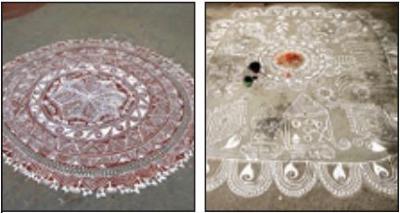
Kolkata :
It was at Kala Bhavan that the idea of including alpana as part of the fine arts syllabus germinated, through a series of workshops that Rabi Biswas was called in to conduct. Biswas, in fact, has been crusading to revive folk alpana, with foundations like Daricha and Intach playing a key role.
To most of us, the word alpana means patterns drawn with rice paste on auspicious occasions. In today’s age, when one has very little time to soak and grind rice to make the paste and then take time out to draw the patterns, stickers make for easy use. The result is that one of the most vibrant folk traditions of Bengal is gradually becoming extinct.
However, two of the country’s premier art schools have taken it upon themselves to make alpana a part of their teaching-learning process, to help start a revival of sorts.
The one-year foundation course at Kala Bhavan – compulsory for all students taking up fine arts at the undergraduate level – has been revised to include alpana, both in the Santiniketan gharana that was perfected by Nandalal Bose’s daughters Jamuna Devi and Gauri Bhanja, and also the genre inspired by folk traditions. “All students of painting, sculpture, graphics, design and art history have to first go through the foundation course, get their grades and then be given a chance to choose their specializations,” said principal Dilip Mitra. ” Alpana now features in the foundation course because we want every student to be aware of both the Santiniketan and the folk traditions. This will save it from extinction.”
The most popular among these are the six different kinds of ‘Lakshmi brotos’, coupled with specific corresponding alpanas. There are brotos in the monsoon for sowing paddy seeds popular in Birbhum, Burdwan, Bankura and Purulia, where the paddy sheaf is the central alpana motif, brotos for the Nabanna festival, for a custom called Punyipukur, where the pond and the lotus are the central motifs, for Dasputul, where the alpana is inspired by the ‘Ramayana’, the Senjuti broto that characterizes evenings in the month of Agrahayana, with a 52-motif elaborate alpana, the Jampukur broto where the god of death is appeased through rituals and alpanas, and the Hyachra broto to ward off seasonal diseases like chicken pox.
Though unrelated to the Visva-Bharati initiative, similar alpana workshops by Biswas were a routine affair at Rabindra Bharati University at its state academy of dance, drama, music and visual art. “We are toying with the idea of expanding a portion of the painting syllabus to include folk traditions from Bengal, including alpana of the different districts,” said head of the painting department at RBU, Nikhil Pal.
source: http://www.timesofindia.indiatimes.com / The Times of India / News Home> City> Kolkata / TNN / August 15th, 2016